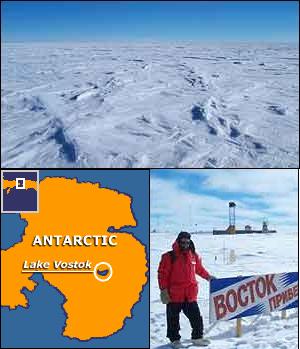Recent measurements will provide a precise mapping of the bottom of Lake Vostok, which lies beneath the Antarctic ice sheets. If microorganisms are found in this hostile environment, it would be a hint that life could exist on other worlds that are not conducive to life as we know it.
Alluvial container, Galileo

About the center of Antarctica is a lake of liquid fresh water, buried under a layer of ice three to four kilometers thick. The lake, called Vostok after a Russian research station established there in 1957, was discovered in 1996 and detected by seismic means and by means of an ice-penetrating radar that maps the continent from aircraft and from space.
There are several dozen such lakes in Antarctica, and Lake Vostok is significantly larger than the others. The water remains in a liquid accumulation state thanks to the great pressure that prevails at this depth, and the geothermal heat that originates in the center of the earth penetrating through the layer of rocks at the base of the continent. The ice layer isolates the water from the low temperature prevailing on the surface. For comparison, in 1983 the lowest temperature ever measured on Earth was measured at the Vostok research station: -89 degrees Celsius.
These are unfriendly conditions for life. The water is under a lot of pressure, and contains oxygen in a concentration up to 50 times higher than normal lakes on the surface of the country. It is a cold environment, cut off from fresh air and sunlight and poor in food sources. This environment is somewhat reminiscent of the existing environment, apparently, on the moon "Europa" - our ice-covered satellite of the planet Jupiter.
A hint of another life
If microorganisms are found in this hostile environment, it would be a hint that life could exist on other worlds that are not conducive to life as we know it. It is possible that heat and minerals from geothermal sources help life to exist there. Thanks to its ice cover, the lake remained isolated from the rest of the world for hundreds of thousands and even millions of years.
If different conditions existed in Antarctica in the past, in which tiny creatures that are no longer known today would thrive, or if there are living creatures capable of existing in these extreme conditions - it is possible to find them in the waters of the lake. It is also possible to find thousands of years old life that originated on the surface, which reached the waters of the lake through a gradual process of drifting ice to depth.
not to harm the continent
As part of the research carried out in Antarctica, microorganisms were discovered in the ice that is slightly above the surface of the lake. At the moment there is no planned intrusion into the waters of the lake; There is a danger that careless research will damage this one-of-a-kind continent, contaminating the ancient water and ice with microorganisms from the modern world. Another scenario, improbable but loved by fans of apocalyptic ideas, is that research in the depths of the lake will bring to the surface a disease-causing microorganism, against which humanity will not be able to fight.
The mapping of the lake was done by Columbia University's Lamont-Doherty Earth Observatory in collaboration with the University of Tokyo, and was carried out by various means, including an ice-penetrating radar that scans the continent from above, and gravitational mapping using aircraft passing over the continent. A recent development in research dealing with Lake Vostok reveals that the lake actually consists of two basins, partially separated by a ridge that limits the passage of water between them.
Differences between the basins
It follows that the two basins may have a different chemical composition and a separate biological population, especially in the bottom. There are differences in the movement of the ice in relation to the basins, as well as in the patterns of its thawing and refreezing. It seems that the northern basin contains ice and rocks that reached it from the surface with the movement of the ice, while the southern basin is more isolated, and preserves alluvium and sediments that formed before the ice sheet covered the continent.
